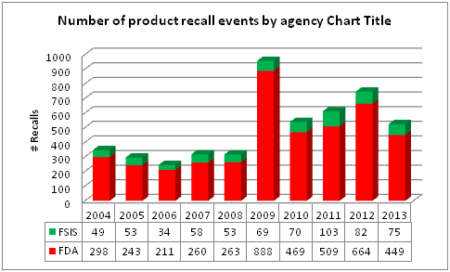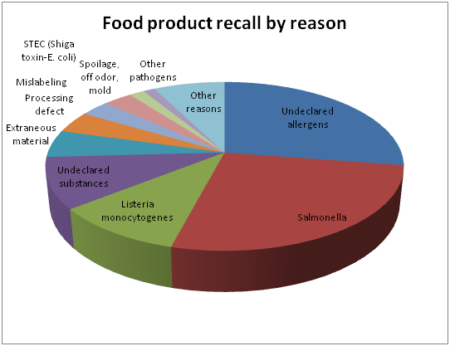Trends in Food Recall 2004-2013- USDA Report, April 2018
Summary
 A report published by the United State Department of Agriculture (USDA) Economic Research Service (ERS) analyzing both FDA and USDA recall data reveals that the number of recalls increased for many food categories such as grain products, animal products, and prepared meals. In the decade from 2004 to 2013 food recalls increased from an average of 304 to 676. A leading cause of food recalls was due to undeclared allergens, where the recalls almost doubled over the decade.
A report published by the United State Department of Agriculture (USDA) Economic Research Service (ERS) analyzing both FDA and USDA recall data reveals that the number of recalls increased for many food categories such as grain products, animal products, and prepared meals. In the decade from 2004 to 2013 food recalls increased from an average of 304 to 676. A leading cause of food recalls was due to undeclared allergens, where the recalls almost doubled over the decade.
Increase in Recalls over the Years
During the period 2004-2013 FDA and FSIS monitored 4,900 products recalls. Most (86.8%) were FDA recalls. The significant increase in 2009 seen in the figure below was due to the peanut butter recall in January and the pistachio recall in March of 2009. The Salmonella in peanut butter caused 714 illnesses and 9 deaths.
Peanut butter and peanut paste are frequently used in cookies, crackers, cereal, candy, ice cream, and other foods. Therefore, over 400 separate recalls resulted from the primary recall.

The growth in recalls over the decade was significantly larger than the growth in annual food production. However, these increases in numbers of recalls were not associated with an increase in illnesses due to food pathogens.
The author speculates that the increase in recalls might be due to improvement in methodology and the expansion of external auditing. A report by HHS Office of the Inspector General (OIG) showed that 17,032 facilities were inspected in 2004, increasing to 19,369 facilities in 2011, and decreasing to 16,846 by 2013.
Another hypothesis for the increase in numbers of recall is an increasingly complex food supply system, improvements in the detection of health risk, and increased regulatory oversight. An additional reason the author mention is the passing of two major food policy laws (FALCPA and FSMA) that could have contributed to the increase in food recalls.
Food Allergen Labeling and Consumer Protection Act (FALCPA) is the probable reason for the dramatic rise in the number of undeclared allergens recalls. The increase in undeclared allergens recalls suggests that food companies should spend more time and effort reviewing labels to ensure they are accurate before the sale of the product.
Recall by Food Categories
The average number of recalls increased for all food categories in the second half of the decade as compared to the first half. However, most of the increases are not statistically significant.
The majority of food recalls in 2004-13 occurred in six categories: prepared foods and meals, excluding soups (11.9%); nuts, seeds, and nut products (10.9%); baked goods (9%); grains and grain products (8.4%); candy products (7.9%); and sauces, condiments and dressings (5%).

According to the CDC, Produce and meat-poultry commodities accounted for the majority of foodborne illnesses, hospitalizations, and deaths between 1998 and 2008.
Fresh produce recalls increased over this ten year period. It showed a significant increase in 2012 due to two Salmonella outbreaks (cantaloupes and mangos). Leafy greens recall also increased significantly through the decade, as did recalls for meat, poultry, and seafood.
Recall Reasons
The report categorizes reasons for recall into seven main groups: pathogen contamination, undeclared major allergens, undeclared substances, extraneous material, processing defects, mislabeling, and other. The high percentage of recalls due to Salmonella was impacted by the vast peanut butter recall followed by the pistachio recall.

Combining all pathogens recalls (Shiga toxin-producing Escherichia coli, Salmonella, and others) resulted in 41.0% of all recalls. Undeclared allergens contributed 27.4% of the recalls, nearly doubling over the decade. The passage of FALCPA likely played a significant role in the growing number of undeclared allergen recalls.
In produce recall, 91.9% of the cases were due to microbial contamination (e.g., Salmonella, Listeria monocytogenes, and STEC). However, these three pathogens accounted for just 40% of meat, poultry and seafood recall.
Common food ingredients may have an exponential impact on recalls, as was the case with the recall of the peanut butter. From 2004 through 2013, 22.4% of all recalls were the result of an upstream ingredient being recalled first.
